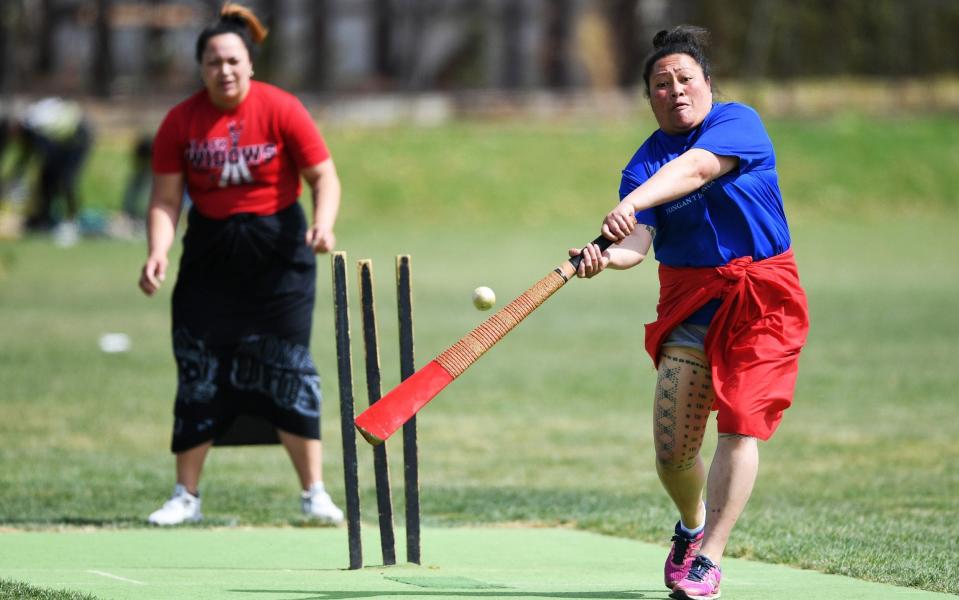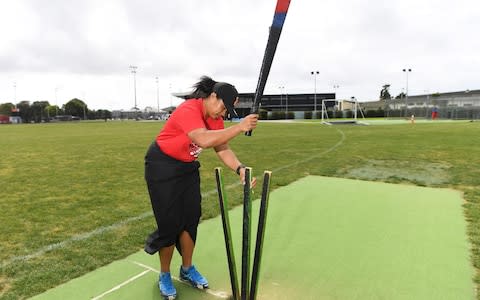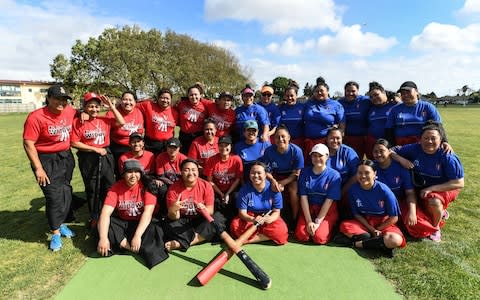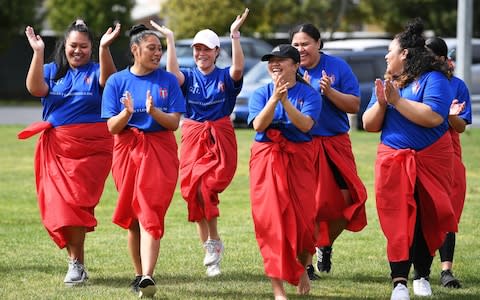All you need to know about 'kilikiti', the joyous cousin of cricket that forged Black Caps' biggest hitters


The moment a wicket falls, the fielder at mid-on blows a whistle and begins an elaborate ritual. Every fielder dances and claps hands rhythmically, and chants as the batter departs – running, not surprisingly, rather than walking off the field.
In conventional men’s cricket this would be gloating, or triumphalism: giving a batsman such a send-off is just not done. But this is Samoan women’s cricket, or “kilikiti”, at Papatoetoe Cricket Club in south Auckland, New Zealand, the city’s most deprived area, where if you can find a job it will be shift work.
The stumps are half as tall again as normal ones and the ball is rubber. The bat – like a triangular baseball club but twice the length – is made from breadfruit trees, the upper half wrapped with string, with all the care lavished on English willow.
The kilikiti league season in Auckland does not begin until January, but an exhibition game was staged on Saturday for the Telegraph. A quick game is said to be a good game and this one was wrapped up in less than two hours; so a player can often enjoy three games in a day. The ball is bowled from one end, then the other, alternately: in effect one-ball overs. Fielders, whenever they are not singing or dancing, are running into position, not standing around for whole overs at a time.
Black Widows, who were captained by Maliah Tato, a primary schoolteacher and head of maths, scored 40 runs off their 60 balls. St Pius X Catholic Church won off the last of their 60 balls after losing 12 of their 15 batsmen (teams are normally made up of 20 players).
The standard of throwing and catching was remarkably skilled: the St Pius team did not drop a single catch, though the high ball was blown by a typically bracing North Island wind. Some of the bowling was as quick as in the Women’s Big Bash League in Australia. Off-side shots are awkward with an elongated bat, but several balls were pulled to the square leg boundary not simply of the kilikiti field but of the ground beyond, which was being used for a conventional men’s league game.
It may be coincidence, but the two highest innings made against England in white-ball cricket were played by batsmen who grew up playing kilikiti: Martin Guptill, who scored 189 in an ODI at the Ageas Bowl, and Ross Taylor who made 181 in Dunedin last year. Sir Viv Richards also scored 189 against England, but that was in 1984, when red balls were used in ODIs; and he was unique.

Taylor recalled the kilikiti of his childhood during New Zealand’s flight from Napier to Auckland for the fifth T20 international at Eden Park. Throughout his career – he is on course to play his 100th Test in February – Taylor has been as admirable as Sir Alastair Cook in his on-field behaviour.
“The links between religion and sport in Samoan culture are very strong,” said Taylor – a factor that accounts for the St Pius X Church having a kilikiti team.
“When I used to play with my cousins, it was church versus church in Wellington on a Saturday. I was about eight or nine and they’d wonder if they should bowl slowly to me, but they said no, no, he plays what they call palangi cricket – the white man’s game – and by the end of it they were bowling as fast as they could.

“You’ve just got to go and hit every ball because it’s rubber, which bounces quite a lot – and given a bat like a triangle, a three-sided shape, it’s probably easier to just smack it leg side. That probably helps me out in T20 but maybe not so much in Tests. I did play hockey as a youngster, so it was a bit of hockey and kilikiti.
“You celebrate when you get a wicket – everybody does a bit of a dance and whistles. It’s a celebration without sledging, I guess. I haven’t played for a while but I found out recently that Martin Guptill used to play kilikiti in an Auckland secondary schools competition.”
Coaches were gravely displeased if a pupil used a bat that was too heavy, for he could not raise his left elbow sufficiently high. However, for the purposes of white-ball hitting, it may be better to grow up with a heavy bat so the bottom hand is strengthened to do the work.

Kilikiti began in Samoa in 1884 when Christian missionaries were seen disporting. William Churchwood, the then British consul in Apia, recorded: “For a time all went on very smoothly, but the quiet and serious English style did not suit them long. One by one, innovations of their own manufacture crept into the game, until soon nothing remained of cricket, pur et simple, but the practice of one man bowling a ball to another man trying to hit it. Samoan cricket found great favour all round, giving as it did in its improved form the excuse, always welcome, and never rejected, for feasting and parade, so dear to all Samoans.”
“It needs to be separate because it’s so different,” Taylor said about kilikiti’s future. “For me it’s celebrating that format, but I’d love a lot more Pacific Islanders to play the game of cricket, and that [kilikiti] is probably not a bad avenue. There are a few Polynesians in the Auckland side so I’m sure at some stage they would have played kilikiti.”

When we adjourn to the Papatoetoe clubhouse for an ample late lunch – before which Maliah says a lengthy grace – the jugs of cider flow. Maliah not only plays kilikiti, she is a member of the Samoan women’s team, who won the gold medal for official cricket at the South Pacific Games this year.
“This summer, for the first time, the women in the Super Smash will be paid,” Maliah said. New Zealand’s T20 competition, for the six regional teams, will have the female sides playing before the male sides.
And while everyone eats and drinks – for whether it is kilikiti or cricket, the game is all about running around in the sun, focusing on a ball to the exclusion of your troubles, then socialising with your mates and opponents – the women’s Big Bash League is being shown live on the clubhouse television, raising the prospect of careers, more pleasant than shift work, that had never existed.

 Yahoo Sport
Yahoo Sport 





































